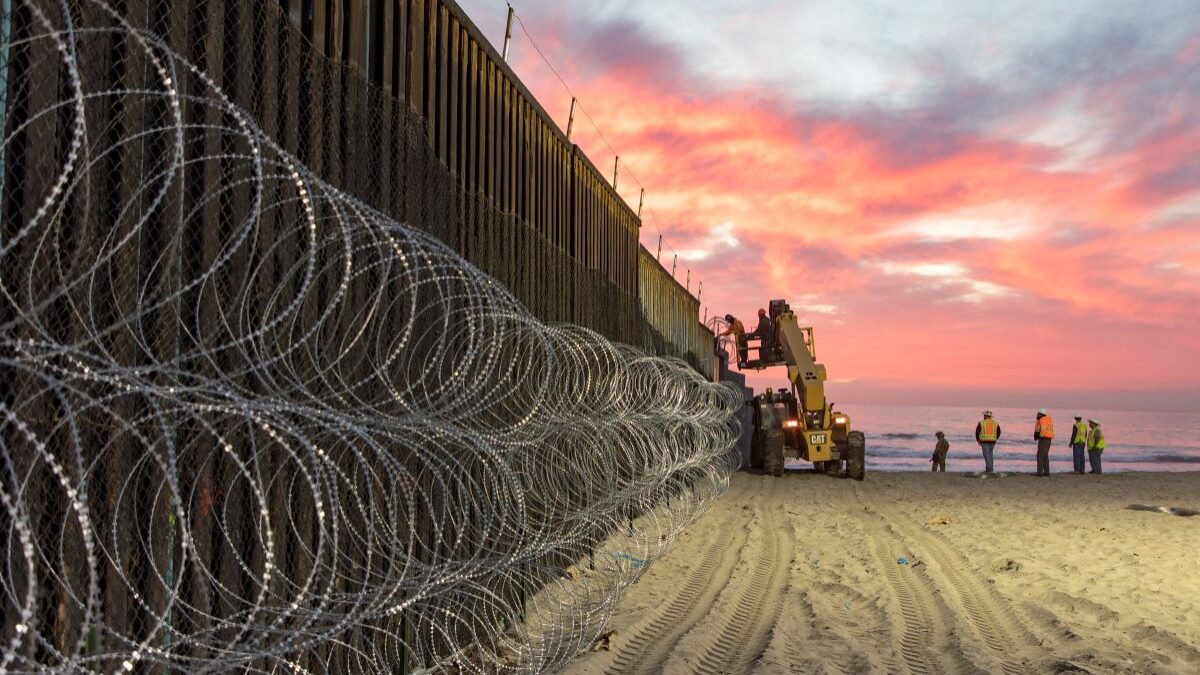
If Americans were honest with themselves, would they admit that they benefit from illegal immigration? According to a recent article in The Federalist, they would.
The author says, “All Americans — not just large farms and meatpacking plants — benefit from illegal immigration by paying lower prices for food. If industrial farms and meatpacking plants across the country refused to hire foreign workers and decided to pay competitive wages that would attract American workers, we would all pay much more for meat, fruit, and vegetables.”
Yet we’re not convinced that mass illegal immigration does produce an overall economic gain. The economics are much more nuanced. The argument that illegal immigration is a net benefit is characteristic of a blinkered view of social costs that is unfortunately prevalent among libertarians and conservatives.
Yes, American consumers may be paying less for the cabbages and the lettuce leaves harvested by illegal workers whose labor is cheap. But that is just the beginning of the analysis, not its conclusion.
The Problem of ‘Negative Externalities’
The argument about cheaper goods ignores what economists call the problem of externalities. Suppose, for instance, that widgets normally sell for 75 cents. But a widget manufacturer comes up with a method of production that costs the manufacturer only a penny to make a widget. So the manufacturer can undercut its competition by selling a widget for as little as 2 cents. The lower cost of the widget to consumers is an obvious gain to society as a whole, isn’t it?
Not necessarily. Suppose the new technique for manufacturing widgets requires the manufacturer to dump a toxic substance in a nearby river. Let’s posit that the pollution caused by manufacturing each one-penny widget costs 99 cents in damages, spread out among others who depend on the river. Overall, then, the cost of manufacturing the penny widget is $1 (1 cent plus 99 cents).
If the manufacturer of the cheap widgets had to bear the full costs of making the product — “internalizing” those “externalities” — instead of passing most of those costs through to the local tourism or fishing industries, then it would cost a dollar, not a penny, for it to make a widget. And it would have to charge at least $1.01, not 2 cents, per widget, to make a profit. Now the 75 cent, nonpollutive widget represents the greater benefit for society.
How is this relevant to assessing the overall social cost of mass illegal immigration? Because you have to consider the “negative externalities” of such mass illegality. You can’t just compare what the price of a head of lettuce in the supermarket would be if it were picked by American citizens — or lawful immigrants — to its price when illegal immigrants harvest it. You have to see if the industrial farms, meatpacking plants, and other employers of large numbers of illegal immigrants are passing most of their costs to others. And it seems they are.
The Costs of Mass Illegality
We must weigh the costs of illegal immigration to our local, state, and federal governments. Illegal workers and their families have access to taxpayer-provided benefits, such as free public schooling. If some of the current Democrat presidential hopefuls have their way, these workers will enjoy free health care, too (they already enjoy certain medical benefits).
How large is the tally? According to a 2017 study by the Federation for American Immigration Reform, or FAIR, federal and state governments pay nearly $135 billion annually to cover the cost of an estimated 12.5 million illegal immigrants and their 4.2 million citizen children present in the country.
FAIR found the cost of federal provision of medical care to be about $17 billion alone. The total state and local burden for education was $44.4 billion, for general public services $18.5 billion, and for medical care $12.1 billion. That would buy you a lot of lettuce.
Of course, you can quarrel with FAIR’s study. Maybe FAIR has overestimated the number of illegal immigrants in the country (unlikely), or maybe its cost figures are too high. Also, as the FAIR study notes, the costs to the government are to some degree offset by the taxes illegal workers may pay. Finally, FAIR unquestionably has an agenda, and one would need to consult studies by other groups.
But our point is not to represent FAIR’s study as definitive. It is that any sound analysis of the overall costs and benefits of mass illegal immigration has to probe much more deeply than merely looking at comparative food costs. And other costs should be added to the tally.
Fraud and Crime Cost Taxpayers, Too
For one, costs are incurred from fraud and tax evasion of illegal workers. As The Federalist author rightly notes, many illegal workers use fake IDs — for instance, for Social Security. This practice can cheat honest taxpayers of the benefits due to them from Social Security, and it jacks up administrative monitoring and enforcement costs. Consider also the additional policing costs for the crimes and violence committed by low-wage illegal immigrants, and by the unemployed and poor workers for whose legal labor theirs has been substituted, and turn to crime as a result.
Advocates for illegal immigration love to say illegal immigrants are more law-abiding than native-born Americans. We doubt this is so. The data collection on this question is limited (some would say for political reasons).
But the U.S. Sentencing Commission reports that noncitizens, about 7 percent of the population, receive 22 percent of federal murder convictions, 18 percent of fraud convictions, 33 percent of money laundering convictions, and 29 percent of drug trafficking convictions. (By the way, until Trump was elected, the federal government had withheld this information for years). In many states where the available data make measurement possible, illegal immigrants also commit a disproportionate number of violent and drug crimes.
Pricing Low-Wage Americans Out of Jobs
There are other less-visible, but still very real, costs. Until only several years ago, real wages for the median American worker had been largely flat for 30 years and had declined since the late 1990s. A cheap-labor economy that doesn’t advance toward higher real wages is likely to be a non-innovative, technologically arrested economy. A high-wage economy will tend to have the opposite effect.
Where labor is ultra-cheap and abundant, employers won’t be forced to search for new, labor-saving technologies that will lower their costs of production. Indeed, America’s economy is plagued by too little long-term capital expenditure, in real terms relative to our existing capital stock (means of production). This may be in part due to a steady influx of cheap illegal labor.
Moreover, mass illegal immigration on the scale now occurring in the United States undermines respect for the rule of law generally, whether by citizens or by the government. If we tolerate massive, obvious noncompliance with immigration laws, we seem to be encouraging noncompliance with, or non-enforcement of, other laws.
The Obama administration publicly stated it would not enforce the nation’s deportation laws with a large class of illegal aliens (the “Dreamers”), but instead provide them benefits. (A split Supreme Court upheld a lower-court decision blocking implementation of the Obama policy, but the issue remains alive). When individual people and even whole governments disregard the law, respect for the rule of law dwindles.
Consider, too, the fundamental question of what it means to be a true national community, rather than a mere administrative and economic unit that happens to occupy a certain space. Do we as a society really want to enjoy lower prices for lettuce heads when it means U.S. citizens are priced out of jobs — and themselves become charges on the public? When it means poor, unskilled workers in Mississippi cannot enjoy higher wages or get entry-level jobs?
Wouldn’t most Americans be willing to pay a tad more for their lettuce if they knew this meant providing more jobs at better pay for other Americans? And shouldn’t our government try to encourage that feeling?
Unfairness to the Most Vulnerable
This brings us to an often neglected cost of a steady influx in illegal cheap labor: It harms our worst-off the most. Sometimes, advocates say, illegal immigrants do not take jobs from Americans. That idea carries a certain plausibility, at first: Maybe American workers are simply unwilling to do most of the jobs illegal workers fill. But whether or not that is so, it should not blind us to the skewed distributional effects of mass illegal immigration.
The Harvard economist George Borjas, a lawful immigrant from Cuba, noted this point after studying the mass influx of low-skilled Cuban workers to Florida in the 1980s from the Mariel boatlift. Borjas found that the influx caused the average wage of the least-skilled Miamians to drop “dramatically,” by 10 to 30 percent.
The intellectually honest debate over Borjas’ work going forward seems to be over how long these wage effects last, and whether they can help explain persisting low real-wage growth for the country overall. The worst-affected may even be earlier generations of immigrants. Given a steady flow of low-skilled immigration into the United States, the effects nationwide are less dramatic than they were in Miami, but they may be deep and long-lasting. Borjas has also found that to be true.
Writing in Politico during the 2016 presidential campaign, Borjas noted the unequal effects of mass immigration — both legal and illegal — on our native population. Borjas wrote:
Both low and high-skilled natives are affected by the influx of immigrants. But because a disproportionate percentage of immigrants have few skills, it is low-skilled American workers, including many blacks and Hispanics, who have suffered most from this wage dip. The monetary loss is sizable. The typical high school dropout earns about $25,000 annually. According to census data, immigrants admitted in the past two decades lacking a high school diploma have increased the size of the low-skilled workforce by roughly 25 percent. As a result, the earnings of this particularly vulnerable group dropped by between $800 and $1,500 each year.
A caring and compassionate nation cares about the poor, starting with its own poor. And a responsible democratic government puts the interests of its own people, particularly the most vulnerable, first. Let the privileged advocates of illegal mass immigration think about that when eating their arugula.









